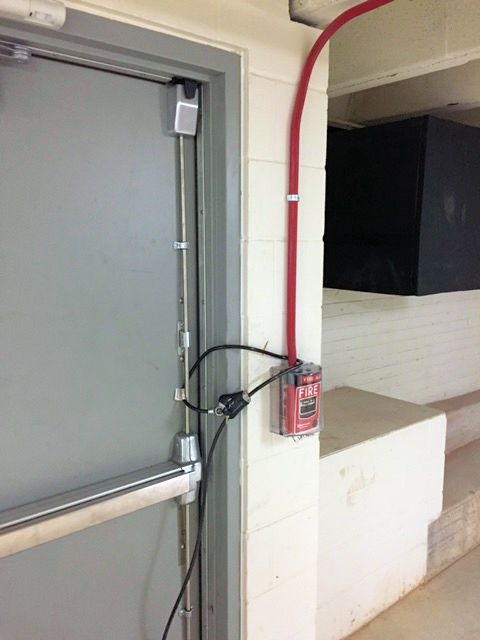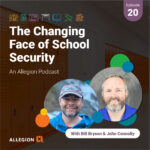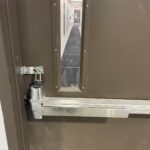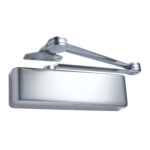This post has a lot going on. First, since it’s Fixed-it Friday and I don’t want to disappoint anyone, here’s a photo from Bill Stock of Johnson Hardware. This is an exit door in a school, and I’m confident that you’ll easily spot the problematic “fix” (scroll down and keep reading).
~~~
Next, if you’ve been following the current code development cycle you’ll remember that NFPA was considering a change to NFPA 101 – The Life Safety Code that would allow 2 releasing operations for existing classroom doors instead of 1 (I wrote all about it here). There there was a vote at NFPA’s technical meeting, where the voters overwhelming voted to stick with the limit of 1 releasing operation that has been part of NFPA 101 for 3 decades. Shortly after the vote, 2 appeals were filed which were discussed at a meeting of the NFPA Standards Council on August 15th.
The final decision of the Standards Council was communicated in a letter dated August 31st. Here’s a short excerpt from the letter (the complete letter can be downloaded from NFPA’s website under Final Decisions-NFPA 101):
“In the view of the Council, this appeal does not present any clear and substantial basis upon which to overturn the results yielded by the NFPA standards development process. Accordingly, the Council has voted to deny the appeal. The effect of this action is that the text allowing for not more than two releasing operations will not be included in Section 15.2.2.2.4, Section 17.2.2.2.6, nor Section 39.2.2.2.2 of NFPA 101 Life Safety Code, 2018 edition.”
~~~
Here is the relevant language from Chapter 14 of the 2018 edition of NFPA 101, which applies to new educational occupancies:
14.2.2.2.4* Classroom Door Locking to Prevent Unwanted Entry.
(1) The locking means shall be capable of being engaged without opening the door.
(2) The unlocking and unlatching from the classroom side of the door can be accomplished without the use of a key, tool, or special knowledge or effort.
(3) The releasing mechanism shall open the door leaf with not more than one releasing operation.
(4) The releasing mechanism for unlocking and unlatching shall be located at a height not less than 34 in. (865 mm) and not exceeding 48 in. (1220 mm) above the finished floor.
(5) Locks, if remotely engaged, shall be unlockable from the classroom side of the door without the use of a key, tool, or special knowledge or effort.
(6) The door shall be capable of being unlocked and opened from outside the room with the necessary key or other credential.
(7) The locking means shall not modify the door closer, panic hardware, or fire exit hardware.
(8) Modifications to fire door assemblies, including door hardware, shall be in accordance with NFPA 80.
(9) The emergency action plan, required by 14.7.1, shall address the use of the locking and unlocking means from within and outside the room.
(10) Staff shall be drilled in the engagement and release of the locking means, from within and outside the room, as part of the emergency egress drills required by 14.7.2.
~~~
Finally, even if you were not able to attend the NFPA conference in June, you can still learn from Ron Coté’s presentation on classroom security – the video is below. Ron even mentioned iDigHardware at about 2:20 into the video and again at the end! 😀
The possibility of 2-operation unlatching that is discussed in this presentation will not be part of the 2018 edition of NFPA 101…the class was held before the vote. In addition, there is some discussion during the class about having to be able to lock the door without the use of the key. As far as I know, this is not the intent of the new NFPA language, which prohibits the use of a key to unlatch or unlock the classroom door but would allow a key to lock the door as long as the door could be locked from inside of the classroom. Update: I spoke to Ron about this part of the presentation and he misspoke during the class…it happens to the best of us! It is acceptable for a key to be required to lock the door from within the classroom, but a key can’t be required to unlock the door for egress.
The 2018 edition of NFPA 101 will be available to order through NFPA’s website in October.
You need to login or register to bookmark/favorite this content.






Of course iDigHardware.com was Mentioned, if you are talking about Doors/Codes somewhere you will where iDigHardware.com!!
Glad they ditched the barrier (2 actions) but did not know the classroom security function was going to be removed (If I followed correct) I don’t like that they removed that.
Hi John –
I don’t think that the classroom security function is being removed. The NFPA 101 language says that a key can’t be required to unlock or unlatch the door for egress. It doesn’t say that the key can’t be used to lock the door – as long as it can be done from inside of the classroom.
– Lori
The two-step and barricade approaches were well-meant, but too easy and too dangerous. Without being too dramatic, I think your championing of safe classroom security will ultimately lead to saving children’s lives, as well as compel the hardware industry to innovate improved locking technologies. Just my opinion…
I am extremely happy to see the win, but I am also confident that they will regroup and come at it again.
I hope as more schools get renovated with proper builders security hardware that will keep students secure and safe the available market for these other products will diminish, and so will the funding for them to continue to try and sell a non-compliant solutions.
That’s great news, but what does this mean for all of the schools that have installed barricade apparatus?
Hi Gretchen –
If a state has not modified their codes and the AHJ has not officially stated that they will allow classroom barricade devices, the schools should be complying with the current model codes that have been adopted there. The model codes currently (and previously) require one operation to release the latch, which means that a barricade device can’t be used on a door with existing latching hardware. There are other existing code requirements that also impact the use of barricade devices, like the mounting height, no tight grasping/pinching/twisting, and no key/tool/special knowledge/effort. The new codes will reinforce the existing requirements and add a requirement for the door to be unlockable from the outside. If a school purchased barricade devices without a code modification or approval from the AHJ, they have likely been non-code-compliant all along.
If the state code has modified these requirements or if the AHJ is allowing barricade devices to be used, there is still the question of accessibility. I have spoken with several accessibility experts and have been told that the accessibility standards apply, even in an intruder situation. Because the ADA is a federal law, it applies even if a state code modification has been made. Unfortunately, it will probably take a lawsuit to get the ADA enforced, and it may take a tragic incident to establish case law before someone is willing to file a lawsuit.
– Lori
Glad to see the NFPA working to keep everyone safe by telling us what new device’s we should not use.
Can we get a group to keep us up to date on new products or devices that do meet the standards. There has to be new products out there that help to keep us saver and meet approval.